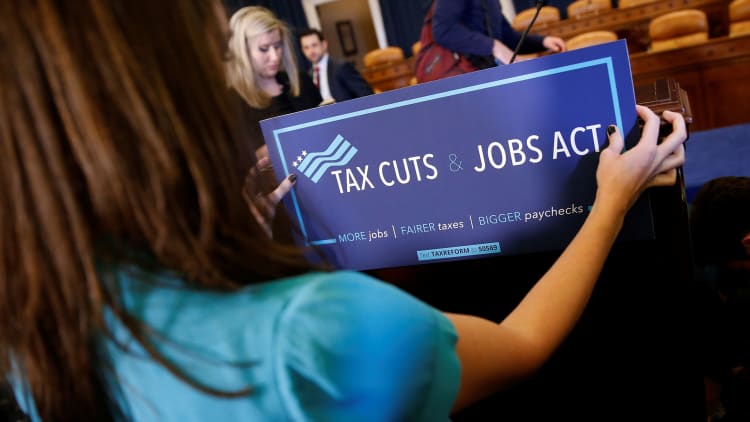
The winners and losers of the Republican tax proposal are beginning to emerge.
Lawmakers released the Tax Cuts and Jobs Act on Thursday. The proposed legislation aims to simplify the tax code by slashing itemized deductions and cutting down the number of income tax brackets.
Republicans are also seeking to reduce the federal corporate tax rate to 20 percent from its current maximum level of 35 percent.
"There will be winners and losers in tax reform, and as it stands now, I worry that the benefits that are claimed to go to middle-income households won't play out," said Bill Hoagland, senior vice president at the Bipartisan Policy Center.
Here's how your tax picture may change if the legislation is adopted without major changes.
Increasing the standard deduction
Losers: Low-income filers with children.
Winners: Low- to middle-income households.
House Republicans want to raise standard deductions to $24,000 for married taxpayers who file jointly and $12,000 for single filers.
That's up from $12,700 for married couples and $6,350 for individuals.
Yet this change isn't as generous as it appears, according to Stan Veliotis, associate professor and director of the Center for Professional Accounting Practices at Fordham University in New York.
Under the current system, a single filer can take a standard deduction of $6,350 and a personal exemption of $4,050. That equates to $10,400 in tax savings compared with the proposed $12,000 standard deduction for singles.
Further, the new framework may not be beneficial to large families as it does away with the dependent exemption, which provides $4,050 for each qualifying dependent.
"Dependents are the major thrust," said Veliotis. "If you take away the dependent exemption for my five kids, that's $20,000, and the enhanced standard deduction won't do it for me."
Republicans proposed raising the child tax credit to $1,600 from $1,000.They are also calling for a new $300 credit for each parent and nonchild dependents.
New income tax brackets
As part of their bill, House Republicans are cutting down income tax brackets to four.
Currently, there are seven tax brackets: 10 percent, 15, percent, 25 percent, 28 percent, 33 percent, 35 percent and 39.6 percent.
Under the House bill there will be four brackets: 12 percent, 25 percent, 35 percent and 39.6 percent.
- 12 percent: This rate applies to single filers above $12,000, up to $45,000. Married couples are subject to this rate starting at $24,000, up to $90,000.
- 25 percent: For single filers, this rate applies at $45,000 of taxable income. Joint filers who are married are subject to this rate starting at $90,000.
- 35 percent: This rate applies at $200,000 for singles and $260,000 for married couples.
- 39.6 percent: The top rate applies at $500,000 for singles and $1 million for married filers.
Itemized deductions
Losers: Charities, because some itemizers may take the standard deduction instead, student loan borrowers and filers with large medical expenses.
House Republicans are slashing most itemized deductions, but will maintain the charitable giving deduction as is.
Tax breaks that are going out the window include deductions for medical expenses and student loan interest.
You may miss these breaks.
Cost of select tax deductions
| Deduction | Cost 2016-2020 |
|---|---|
| Mortgage interest | $357 billion |
| State and local taxes | $368.8 billion |
| Charitable contributions* | $230.5 billion |
| Property taxes | $180 billion |
| Medical & long-term care expenses | $56.6 billion |
| Student loan interest | $11.9 billion |
| Teacher classroom expenses | $1.2 billion |
Source: Source: Joint Committee on Taxation Jan, 30, 2017 report *Excludes education- and health-related donations
Consider the medical expense deduction, which allows you to deduct qualified medical costs that exceed 10 percent of your adjusted gross income.
"Imagine your mom needs long-term care and you reduce your hours at work to be a caregiver —that's the person for whom this can really matter," said Howard Gleckman, senior fellow in the Urban-Brookings Tax Policy Center at the Urban Institute.
Republicans are also keeping the mortgage interest deduction – with some changes. New home buyers would be able to deduct interest on loans up to $500,000, down from $1 million.
Slashing itemized deductions may have a chilling effect on home purchases and charitable giving. "You have to look at all deductions together and see if they're more or less than the standard deduction," Gleckman said.
"If they are less, you won't itemize and those incentives to buy a house or give to charity suddenly decline," he said.
Reducing SALT
Losers: Residents in states with high income taxes.
Federal breaks for state and local taxes, known as SALT, are among the itemized deductions that Congress seeks to limit.
House Republicans have proposed allowing households to write off state and local property taxes up to $10,000.
The state and local tax deductions are particularly important to households in states with high income taxes, including New York, New Jersey and California.
Households in the Northeast have some of the highest property taxes in the country.
The three counties with the highest median property tax all surpass $10,000 and are in New York, according to the Tax Foundation: Nassau County, Rockland County and Westchester County.
Retirement savings
Winners: Participants who are already in workplace retirement plans.
Lawmakers initially floated the idea of lowering the amount workers can set aside annually in a 401(k) plan on a pretax basis to $2,400, down from the current limit of $18,000. President Donald Trump countered this, declaring in an Oct. 23 tweet that "there will be NO change to your 401(k)."
House Republicans have opted to maintain 401(k) contributions as is.
Small-business owners
Winners: Partnerships, sole proprietorships and S-corporations in the top income tax bracket.
The new framework lowers the maximum rate on business income for so-called pass through entities, including sole proprietorships, partnerships and S-corporations, bringing it down to 25 percent.
Income from "pass throughs" flows to the business owner directly and is currently taxed at that person's individual tax rate, which can be as high as 39.6 percent.
Lawmakers have said they would adopt measures to keep entrepreneurs from recharacterizing their personal income as business income to benefit from the lower rate.
A tax cut on pass-through entities would likely benefit the most successful enterprises, including medical practices, accounting firms, law firms, real estate partnerships and hedge funds, said Gleckman of Urban-Brookings Tax Policy Center.
"For the majority of small businesses, the owners make far less than what would put them in the top tax brackets," he said.
The death of estate taxes
Winners: Wealthy families and their heirs, particularly those who haven't made any estate plans.
Republicans want to repeal the estate tax, a levy of 40 percent that applies to estates that exceed $5.49 million for individual filers or nearly $11 million for married couples, starting in 2024.
Heirs will get relief soon, as the bill would immediately double the estate tax exemption.
The Tax Policy Center estimates that after deductions and credits, 5,460 estates will owe the "death tax" this year.
The estate tax accounts for less than 1 percent of federal revenue, according to the Tax Foundation.
House Republicans will maintain the "step-up" in basis, which allows heirs to receive assets at the market value on the day the original owner died.
Step up vs. no step up
| | Sale price per share | Cost basis | Capital gain per share | Tax per share |
|---|---|---|---|---|
| Step up | $40 | $40 | $0 | $0 |
| No step up | $40 | $2 | $38 | $7.6 |
Source: Source: CNBC
Beneficiaries save on capital gains taxes if they were to sell the asset immediately after inheriting it.
The tax would only apply to the difference between the day the heir received the asset and when he or she sold it.
WATCH: The winners & losers of the proposed tax bill







